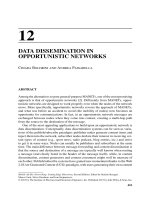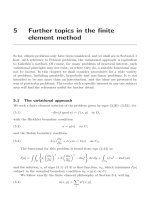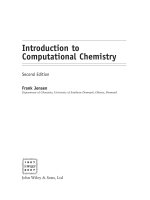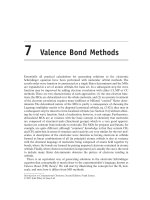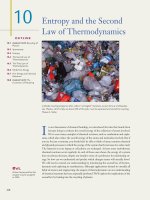Ebook Lange pathology flash cards (2nd edition) Part 2
Bạn đang xem bản rút gọn của tài liệu. Xem và tải ngay bản đầy đủ của tài liệu tại đây (1.91 MB, 220 trang )
Disorders of the
Female Reproductive System
Disorders of
the Breast
Fibrocystic
Disease of
the Breast
Benign Tumors
of the Breast
Breast
Carcinoma
Disorders of
the Ovaries
Disorders of the
Cervix and Uterus
Ovarian Cysts
Endometritis
Polycystic Ovarian
Syndrome
Endometriosis
Ovarian Tumors of
Surface Epithelium
Origin
Leiomyoma
Ovarian Tumors of
Germ Cell Origin
Ovarian Tumors of Sex
Cord-Stromal Origin
Endometrial Carcinoma
Dysplasia, Carcinoma in
Situs, and Squamous Cell
Carcinoma of the Cervix
176
Disorders of
Pregnancy
Other
Disorders
Placental
Attachment
Abnormalities
Neoplasms of
the Vagina
Preeclampsia
and Eclampsia
Pelvic
Inflammatory
Disease
Hydatidiform Mole
and Gestational
Choriocarcinoma
8
Female Reproductive System
Differential Features of Ovarian Masses
Ovarian Mass
Years Affected
Menstrual Irregularity
Malignancy
Follicular cysts
Menstrual years
Anovulation
No
Corpus luteum cysts
Menstrual years
Delayed period
No
Theca-lutein cysts
Menstrual years
Amenorrhea, hCG elevation
No
Dysgerminoma
Kids, young adults
None
Yes
Yolk sac tumor
Kids, young adults
None
Yes
Choriocarcinoma
Premenstrual
None, hCG elevation
Yes
Benign teratoma
All years
None
No
Malignant teratoma
Kids, young adults
None, hCG elevation
Yes
Cystadenocarcinoma
Menstrual years
None
Yes
Endometrioid tumor
Postmenopausal
None
Yes
Granulosa cell tumor
Premenarche or
postmenopausal
Irregular/excessive bleeding
Sometimes
Ovarian thecoma
All years
Irregular
Rarely
Sertoli-Leydig cell tumor
All years
Amenorrhea
No
176
Disorders of the
Male Reproductive System
Tumors of the
Testes
Disorders of the
Prostate
Disorders of the
Penis
8
Testicular Germ
Cell Tumors
Benign Prostate
Hyperplasia
Penile Diseases
Testicular Sex CordGonadal Stroma Tumors
Prostate Carcinoma
Penile Cancers
177
Male Reproductive System
Ovarian and Testicular Tumor Analogues
Ovarian Tumors
Testicular Tumor Analogs
Dysgerminoma
Seminoma
Yolk sac tumor
Endodermal sinus tumor
Ovarian choriocarcinoma
Testicular choriocarcinoma
Ovarian teratoma (benign)
Testicular teratoma (malignant)
Sertoli-Leydig ovarian tumor
Leydig cell (interstitial) tumor, Sertoli cell tumor (androblastoma)
177
A 30-year-old woman presents to your clinic complaining of bilateral, diffuse breast pain. Her
last menstrual period was 2 weeks ago and she says that she has felt several painful masses in
both breasts during her self-examination in the shower. She is very concerned because she has a
sister-in-law, who was recently diagnosed with breast cancer. On physical examination, you
notice multiple, palpable masses on both breasts but no changes to the overlying skin. After taking
a detailed history, you learn that the patient does not drink or smoke, has no immediate family 8
members with a history of breast cancer, and there has been no nipple discharge. You order a fine
needle aspiration cytology, which reveals an aspirate suggestive of a cyst. You reassure the
patient that the lesion is benign and recommend that she avoid trauma to the affected regions and
wear a brassiere that gives good support and protection.
178
Fibrocystic Disease of the Breast
Etiology and
Epidemiology
Caused by hormonal imbalance (increased estrogens and/or decreased progesterones)
Pathology
Several histologic types: (1) Cystic: multiple fluid-filled cysts appear blue (blue-dome cyst),
cysts lined by polygonal cells with eosinophilic granular cytoplasm that are similar to apocrine
epithelium (apocrine metaplasia), may see papillary projections of cystic epithelium; (2) Epithelial
hyperplasia of breast duct: increase in number of epithelial layers in terminal duct lobules resulting
in irregular lumens; (3) Stromal fibrosis: hyperplasia and fibrosis of breast stroma; (4) Sclerosing
adenosis: increased number of acini, stromal fibrosis
Clinical
Manifestations
Presents with diffuse breast pain (midcycle tenderness) and multiple, palpable lesions, often
bilateral; no changes in overlying skin or nipple; rapid fluctuation in size of masses is common
Treatment
Symptom management with pain control
Notes
Fibrocystic disease is the most common breast disorder. Cystic and stromal fibrosis represent no
increased risk for carcinoma, but epithelial hyperplasia and sclerosing adenosis do carry a mildly
increased risk.
Peak incidence is between 25 and 50 years old
178
A 21-year-old African American woman presents to the clinic complaining of a large mass in her
left breast. She has no immediate family members with breast cancer. On physical examination,
you notice that the mass is round, rubbery, mobile, and nontender. It is approximately 4 cm in
diameter. You order a needle biopsy that shows a combination of connective tissue and cystic
spaces taking on a leaflike appearance. You inform the patient that this lesion is most often benign,
but nevertheless you suggest that she be treated with a local excision to remove the growth.
179
8
Benign Tumors of the Breast
Epidemiology
Fibroadenoma (FA): Occurs in women < 40; tends to occur more frequently and at a younger age
in African American women
Phyllodes tumor (PT): Occurs most commonly after the age of 50
Intraductal papilloma (IP): Occurs in middle-aged women
Pathology
FA: Gross: small, mobile, rubbery, firm mass with sharp, well-circumscribed edges.
Microscopic: fibroblastic stroma surrounding cystic and glandular spaces; may regress after
menopause and demonstrate calcifications.
PT: Gross: large, bulky mass of connective tissue and cysts. Microscopic: cystic spaces on cut
section of stroma contains leaflike projections from cyst walls; leaflike appearance on breast surface; 5%–10% undergoes malignant change with atypia (cystosarcoma phyllodes).
IP: Gross: arising from major lactiferous ducts. Microscopic: proliferation of ductal epithelial tissue
in papillary growth manner; apocrine metaplasia.
Clinical
Manifestations
FA and PT: Increased size and tenderness of mass with pregnancy or menstrual cycle; no overlying
skin changes; no lymphadenopathy; no nipple retraction
IP: Presents with nipple discharge
Treatment
FA: No treatment or simple excision
PT: Local excision with wide margin; can recur after resection
IP: Simple excision
Notes
Phyllodes tumor and intraductal papilloma carry a mildly increased risk of breast carcinoma.
179
A 50-year-old woman presents to your clinic after finding a mass on the upper outer quadrant of
her left breast. After taking a thorough history, you learn that her mother died from breast cancer
and her maternal aunt was also diagnosed with breast cancer at an early age. The patient started her
period at age 11, did not bear any children, and has not been through menopause. On physical
examination, she is markedly obese and you notice retraction of the skin and the nipple on her left
breast. You locate the mass in question during your breast examination and find that it is fixed, 8
hard, and nontender. The mass was not present on her last mammogram dating back 2 years. You
also feel palpable axillary lymph nodes. You schedule the patient for an immediate mammography
and needle biopsy to confirm your suspicions.
180
Breast Carcinoma (Part I)
Etiology and
Epidemiology
Risk factors include family history of first-degree relative with breast cancer at young age (highest
risk), autosomal dominant inheritance of mutations in BRCA1 or BRCA2 gene, female gender,
increased age, early first menarche, delayed first pregnancy, nulliparity, late menopause, radiation,
and exogenous estrogen use
Incidence increases with age
Pathology
Infiltrating ductal carcinoma: Tumor cells arranged in cords, islands, or glands embedded in
dense fibrous stroma; may arise from ductal carcinoma in situ (DCIS)
Intraductal comedocarcinoma: Sheet of tumor cells confined within duct; central necrosis;
periductal fibrosis with inflammation
Inflammatory: Lymphatic involvement of overlying skin
Paget disease: Paget cells (large cells with clear halo of pale cytoplasm) extend from ducts and
invade epidermis of nipple; underlying ductal adenocarcinoma within subareolar excretory ducts
always present
Infiltrating lobular: Often multiple and bilateral; cells line up (Indian file) with tumor cells
surrounding lobule in target fashion; signet ring cells; may arise from lobular carcinoma in situ
(LCIS) after many years
Medullary: Solid sheets of cells with large nucleoli in scant stroma; lymphocytic infiltrate
Mucinous (colloid): Pools of extracellular mucin surrounding tumor cell clusters; gelatinous
consistency
Notes
Breast carcinoma is the second most common cause of cancer death among women.
180
A 49-year-old woman presents to your office concerned about a rash on her left nipple that has
developed over the past month. The rash is itchy, but painless. On physical examination, you find
a large eczematous-like patch over the left nipple as well as a fixed mass in the left breast. You
perform both a skin biopsy as well as a needle biopsy of the mass. When the skin biopsy reveals
large cells with a clear halo of pale cytoplasm invading the epidermis, you become certain that
the biopsy of the mass will reveal carcinoma of the breast.
181
8
Breast Carcinoma (Part II)
Clinical
Manifestations
Painless, usually fixed, hard, nontender mass often found in upper outer quadrant of breast;
retraction of overlying skin and nipple; palpable axillary lymph nodes
Infiltrating ductal carcinoma: Firm, fixed, fibrous mass
Inflammatory: Red, swollen, hot, painful to touch, orange-peel appearance of skin
Paget disease: Itchy, scaly, painless, eczematous patches on the nipple
Medullary: Soft, fleshy-consistency mass
Lab findings: Paraneoplastic syndrome with secretion of PTH-related peptide may lead to
hypercalcemia
Imaging: Mammogram with microcalcifications, spiculated or enlarging mass
Treatment
Surgery and radiation therapy; chemotherapy; hormonal therapy (tamoxifen or aromatase
inhibitors) for patients with cancer cells expressing estrogen receptor in their nuclei (ER/PR+);
biologic therapy (herceptin) for patients with HER2/neu expression
Notes
Metastasis occurs to lymph nodes, lung, liver, and bone.
181
A 45-year-old woman presents to the clinic complaining of vague abdominal pain for the past 4 days.
She describes her pain as more of a pelvic pressure that is generalized bilaterally. Her last menstrual
period was 2 weeks ago and she states that she has regular menstrual cycles. She denies the
possibility of pregnancy and is currently not taking oral contraceptives. She has not had any
changes in digestive functions and denies any nausea, vomiting, constipation, or diarrhea. She
has no family history of ovarian cancer. When an ultrasound confirms your suspicions, you place 8
the patient on oral contraceptive pills, believing that her symptoms will disappear in 2 months,
and you schedule her for a follow-up ultrasound.
182
Ovarian Cysts
Etiology and
Epidemiology
Follicular (F) cyst: Associated with hyperestrinism and endometrial hyperplasia; most common cause
of ovarian enlargement; mostly found during menstrual years
Corpus luteum (CL) cyst: Found during menstrual years
Theca-lutein (TL) cyst: Associated with choriocarcinoma, hydatidiform moles, and clomiphene
(synthetic gonadotropin) therapy
Pathology
F: Often bilateral; distention of unruptured Graafian follicle; lined by granulosa cells
CL: Often unilateral; contains clear fluid; lined by yellowish luteal cells with cytoplasmic lipid
droplets; may hemorrhage into persistent mature corpus luteum
TL: Often bilateral and multiple; lined by luteinized theca cells
Clinical
Manifestations
All may be asymptomatic or present with pelvic pressure/pain or vague GI discomfort
F: Pain not associated with menstruation
CL: Delayed menstruation
TL: Amenorrhea. Lab findings: hCG elevated as a result of trophoblastic proliferation.
Treatment
F: Often disappears with 2-month regimen of oral contraceptives; follow with serial ultrasounds;
laparoscopic removal if persistent
CL and TL: Cyst removal or unilateral oophorectomy
Notes
182
A 30-year-old white woman presents to the fertility clinic with her husband, complaining of the
inability to conceive. The couple has already checked the husband’s sperm motility and count,
which are within the normal range. The patient informs you that she has not menstruated for the
last 4 months and that she has had a very irregular and sporadic menstrual cycle all of her life. You
perform a physical examination, finding that the patient is obese with an inordinate amount of
facial hair. She denies any abnormal uterine bleeding. You order serum studies that show ele- 8
vated plasma LH and testosterone and decreased FSH levels. Based on these findings, you
inform the patient that weight reduction will be the most effective treatment for restoring ovulation
and that adjunct therapy with clomiphene can aid in ovulation.
183
Polycystic Ovarian Syndrome (Stein-Leventhal Syndrome)
Etiology and
Epidemiology
Etiology unclear, but it is believed that a dysregulation of enzymes involved in androgen biosynthesis
may be caused by increased LH secretion, thereby resulting in excessive production of androgens;
associated with obesity, Cushing syndrome, congenital adrenal hyperplasia, genetic predisposition,
and androgen-secreting adrenal tumors
Common endocrine disorder affecting 2%–5% of women during reproductive age
Pathology and
Pathophysiology
Pathophysiology: Increased androgen production causes anovulation, multiple follicular cysts,
and theca cell hyperplasia
Gross: Ovaries enlarged; pearly white thickened ovarian capsule; multiple cysts
Microscopic: Cysts have granulosa cell layer and luteinized theca cells; cortical stromal fibrosis
Clinical
Manifestations
Amenorrhea; infertility; obesity; hirsutism (in 70%); insulin resistance with increased risk of
diabetes; virilism; increased risk of breast and endometrial carcinoma
Lab findings: Increased LH, decreased FSH, increased testosterone, evidence of insulin resistance
Treatment
Weight loss; oral contraceptives; metformin for insulin resistance; gonadotropin analogs; ovulation
induction with clomiphene
Notes
183
A 40-year-old woman presents to the emergency room with generalized abdominal pain and pelvic
pressure. After taking a more complete history, you learn that she has not passed stool for the last
3 days and vomited this morning. She tells you that the pain has been steady over the last week.
You order an abdominal/pelvic CT scan, which is inconclusive, but does demonstrate bilateral
enlargement of the ovaries. The patient is taken to the operating room for an exploratory laparotomy
that shows extensive mucinous ascites, cystic epithelial implants on the peritoneal surfaces, and 8
several adhesions. You believe that the patient’s mucinous peritoneal involvement is caused by her
ovarian condition.
184
Ovarian Tumors of Surface Epithelium Origin
Epidemiology
Usually occurs in women > 20 years of age
Pathology
Serous cystadenoma: Bilateral, benign cyst with fallopian tube-like epithelium
Papillary serous cystadenocarcinoma: Bilateral, malignant cysts lined by stratified atypical
epithelium; papillary growth; psammoma bodies
Mucinous cystadenoma: Multilocular, benign cysts with columnar cells filled with mucin
Mucinous cystadenocarcinoma: Malignant tumor with mucus-secreting atypical columnar
epithelium; loss of gland architecture; necrosis
Brenner tumor: Benign tumor with nests of cells resembling bladder transitional epithelium
interspersed in fibrous stroma
Endometrioid tumor: Malignant tumor resembling endometrium
Clear cell tumor: Rare, malignant tumor composed of sheets of clear cells
Clinical
Manifestations
Mild, nonspecific abdominal discomfort; malignant forms may present with weakness, weight loss,
and anorexia; pseudomyxoma peritonei (intraperitoneal accumulation of mucinous material) is
associated with mucinous cystadenocarcinoma
Lab finding: Elevated CA-125 in ovarian carcinomas
Treatment
Tumor removal; oophorectomy or hysterectomy; chemotherapy
Notes
Ovarian epithelial tumors make up 75% of ovarian tumors.
184
An 18-year-old white woman is admitted to your gynecologic service with a 1-month history of
increasing abdominal pain and a rapidly enlarging pelvic mass. While admitting the patient, you
perform a bimanual pelvic examination that reveals a left ovarian mass. This finding is consistent
with the admitting note and was confirmed by abdominal/pelvic CT, which showed that the left
ovary was twice as large as the right ovary. Serum studies demonstrate an elevated AFP level.
There is no inguinal lymph node involvement and no signs of metastasis on imaging studies. Based 8
on your findings, you perform a unilateral oophorectomy and send the diseased ovary for pathologic analysis. Histology shows glomerulus-like structures composed of a central blood vessel
enveloped by germ cells within a space similarly lined by germ cells. These histologic bodies confirm your suspected diagnosis and you start the patient on combination chemotherapy.
185
Ovarian Tumors of Germ Cell Origin
Etiology and
Epidemiology
Risk factors include nulliparity, positive family history of ovarian cancer, mutations in BRCA1 and
BRCA2 genes and high expression of the HER2/neu oncogene
Occurs most commonly in children and young adults (except for teratomas, which can occur at
all ages)
Pathology
Dysgerminoma: Malignant unilateral tumor comprised of large vesicular cells with clear cytoplasm
and central nuclei; analogous to male testicular seminoma
Yolk sac tumor: Malignant tumor with Schiller-Duval bodies (glomerulus-like structure composed
of central blood vessel enveloped by germ cells)
Choriocarcinoma: Aggressive and malignant tumor with areas of necrosis and hemorrhage composed
of neoplastic syncytiotrophoblasts and cytotrophoblasts
Teratoma: 90% of germ cell tumors; mature teratomas (dermoid cysts) are benign; immature
are malignant. Histology: structures from all germ layers.
Struma ovarii: Unilateral ovarian teratoma composed of thyroid tissue
Clinical
Manifestations
Lab findings: Increased AFP (yolk sac), increased hCG (choriocarcinoma)
Treatment
Tumor removal; oophorectomy or hysterectomy; chemotherapy
Notes
Germ cell tumors make up 25% of ovarian tumors.
Mild, nonspecific abdominal discomfort; struma ovarii may lead to hyperthyroidism
185
A 12-year-old girl is brought into the emergency room because of heavy vaginal bleeding. The
child is also complaining of GI discomfort and pelvic pressure. She states that she had her last
menstruation 2 weeks earlier and she is not sexually active. Her first menstruation was at the age
of 10. On physical examination, the child appears to have undergone precocious puberty. A pelvic
examination reveals a palpable right ovarian mass, which is confirmed by a CT scan. Serum studies
show a significantly increased level of circulating estrogen. When a biopsy reveals distinctive, 8
gland-like structures filled with an acidophilic material, you worry that this patient may have an
increased risk of developing endometrial carcinoma later in life if this mass is not removed.
186
Ovarian Tumors of Sex Cord–Stromal Origin
Etiology and
Epidemiology
Risk factors include nulliparity, positive family history of ovarian cancer, mutations in BRCA1 and
BRCA2 genes, and high expression of the HER2/neu oncogene
Affects all age groups
Pathology and
Pathophysiology
Ovarian fibroma-thecoma (OFT): Secretes estrogen; tumor composed of round lipid-containing
cells in addition to well-differentiated fibroblasts
Granulosa cell tumor (GCT): Secretes estrogen, causing endometrial hyperplasia/carcinoma in
adults; characterized by Call-Exner bodies (small follicles filled with eosinophilic secretions) and
small cuboidal, deeply stained granulosa cells arranged in anastomotic cords
Sertoli-Leydig cell tumor (SLCT): Secretes androgens; tumor composed of Sertoli or Leydig cells
interspersed with stroma
Clinical
Manifestations
Mild, nonspecific abdominal discomfort
OFT: Presents with Meig syndrome (triad of ovarian tumor, ascites, and hydrothorax)
GCT: Vaginal bleeding from endometrial hyperplasia; cystic disease of breast; endometrial carcinoma
SLCT: Virilism
Lab findings: Increased estrogen levels (OFT and GCT)
Treatment
Tumor removal; oophorectomy or hysterectomy; chemotherapy
Notes
Ovarian sex cord–stromal tumors are rare.
186
A 31-year-old woman presents to the clinic complaining of abnormal vaginal bleeding. She states
that her last menstrual period was 1 week ago and that she has not experienced abnormal bleeding
before. Her past medical history is notable for two prior episodes of pelvic inflammatory disease
in the last year. She has also been trying to conceive for the last year without success. On pelvic
examination, redness and inflammation of the cervix is visible, but no discharge is apparent. You
obtain an endometrial biopsy, which you suspect will show plasma cells along with macrophages 8
and leukocytes in the glandular lumen. You begin empiric antibiotic therapy to prevent possible
sequelae from the suspected diagnosis.
187
Endometritis
Etiology
Acute endometritis: Caused by trauma, Staphylococcus aureus and Streptococcus species; usually
occurs after delivery or miscarriage
Chronic endometritis: Caused by granulomatous disease, chronic PID, postpartal or postabortal
states, and TB
Pathology
Endometrium: Plasma cells seen with macrophages and lymphocytes
Clinical
Manifestations
Acute: Presents with inflammation after delivery or miscarriage
Treatment
Antibiotic therapy (helps to prevent other sequelae, such as salpingitis)
Notes
Endometrial polyps are masses composed of endometrial tissue within the endometrial cavity.
They tend to occur in women older than 40 years of age and may result in uterine bleeding, but
are usually benign.
Chronic: Presents with abnormal vaginal bleeding, pain, discharge, and infertility
187
A 24-year-old woman presents to the clinic complaining of increased pain and bleeding during
menstruation. Her last three menstruations have been accompanied by increasing intensity of
cramping and larger amounts of blood. She tells you that her menstrual cycle has been irregular
for the last 6 months. After taking a complete history, you learn that she has been having
increased pelvic pain with intercourse. On pelvic examination, you palpate fixed, bilateral ovarian
masses and an MRI reveals chocolate cysts on the ovary. You begin the patient on oral contraceptives 8
and you suggest surgical removal of the masses if the pain persists.
188


